19 January, 2003
Let It Snow!!!
Woke up today and hated to get out of the bag. The winds had died down
considerably to almost nothing. So I was nice and warm in my sleeping bag,
and wanted so much to sleep in, but it was 8:00 am and we were already late
starting. We needed to finish breaking down camp. I got dressed, packed up
my bag, and began packing up my sleeping gear.
When I stumbled out of the tent, I found the skies very much overcast and
looking east down the valley toward Fryxell, you could see a storm moving
in.
I carried my orange clothing bag down the hill and went into the jamesway
for breakfast. The report was that helos were grounded and they were
already at Condition Two at McMurdo.
There are three weather conditions reported by McMurdo Weather. Condition
Three is normal and you can go about your normal activities. You should
always report that you are leaving, with an estimated time for your journey,
and then report in when you return. It is also recommended that you travel
with someone, never alone. Always pack for an emergency and a sudden change
in weather conditions.
Condition Two is when the weather is questionable. You should not travel
out of town unless in a vehicle and with a radio. You cannot travel out of
town by foot and travel should be for essential business only.
Condition One is the most severe condition. You should not leave your
shelter in Condition One. Don't go anywhere... stay put!
Today it was Condition One out at Pegasus Blue Ice Runway, which is out on
the McMurdo Ice Shelf about a two-hour ride from town. In McMurdo, the
status was Condition Two. All helicopters were grounded; therefore, our
scheduled move to the west lobe of Lake Bonney by air was cancelled.
Here at Lake Bonney, we had Condition Two by late morning. We had managed
to break down all our tents and move everything down the hill to the
jamesway. My back was very happy to be carrying things downhill with the
wind behind me. By the end of breakdown, it had begun to snow, so we stored
our gear in the jamesway entry and in one of the lab rooms. The gear bags
the Clothing Distribution Center (CDC) provides you with are not waterproof.
They are fairly resistant to snow so long as it doesn't melt, which it
usually doesn't unless you bring it inside with snow still on it. But we
weren't taking any chances.
It continued to snow for some time, coming down quite heavily and
accumulating. Brenda said she had never seen it snow this much in the Dry
Valleys. It was also a relatively wet snow, enough that you could make
snowballs and a snowman. It snowed so much, Tom, Sarah, and I went out onto
the ice and rolled snow to create a snowman. We carried the parts up the
hill to near the outhouse and assembled it outside the jamesway to the
enjoyment of the rest of our team.
Since our arrival in the Dry Valleys, what has fascinated all of us is the
ability of the Taylor Valley to change appearances so many times throughout
the day. As the sun moves across the sky or the clouds move in and out, the
shadows change and different features come to life. The beauty in the
valley is constantly changing and today was no different. To see the
mountains and hillsides covered in a thin layer of snow created a completely
different atmosphere.
In the early evening, the winds slowed down enough that we felt we were able
to sledge our gear from our present location on the east lobe of Lake
Bonney, over to the west lobe of Lake Bonney. It required two trips using a
Polaris six-wheeler and two sleds. One sled used was a ten-foot wooden
sled, and the other was a six-foot plastic banana sled with a canvas cover
you can lace up to protect your load. We loaded our squishable bags onto
the wooden sled, and wooden boxes and fuel into the banana sled. Then with
Chris driving and Amber in the small flat bed area of the six-wheeler,
facing backwards to monitor the load, we attached the sleds for pulling.
Aaron, Sean, Sarah, and I sat on top of the gear bags on the wooden sled,
and then the banana sled was roped behind that as the six-wheeler made the
one hour journey across the lake, through the narrows connecting the east
and west lobes, and on to the far side of Lake Bonney to our new camp at the
snout of the giant Taylor Glacier.
Six of us made the first journey over, then Chris and I traveled back to
pick up more gear and to transport the rest of our party to the new site. On
our final ride to the west lobe, the views and atmosphere within the valley
changed once more. Now, some of the snow had evaporated, exposing some of
the gravel and sand that covers the mountain slopes. It is so dry in the
Valleys, that the new fallen snow doesn't have time to melt, it just goes
from snow to vapor in a process known as sublimation.
On the final trip to the west lobe, we battled some hearty westerly winds.
This time I rode in the flatbed watching our sleds, while Brenda, Jake, and
Tom rode on the wooden sled. We arrived safely at 12:30 am. The winds were
really gusting by then, with speeds approaching 30 knots (approx. 40 mph).
We spent some time piling extra rocks onto the edges of our tents, then
headed into the cook tent for a quick hot drink before retiring to out tents
for the night.
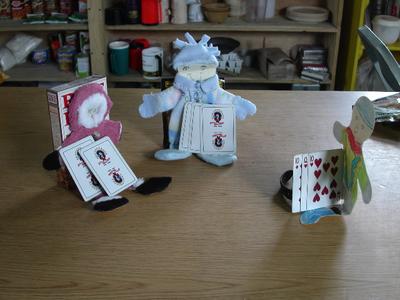
Waiting for the storm to ease up, the Flat Stanley Family decides to play a little game of "Go Fish".

Penguin Paul met a new friend in the Lake Bonney jamesway to hang out with.
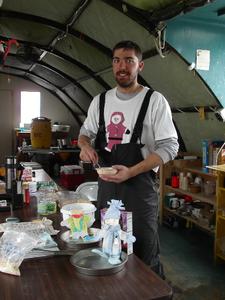
The Flat Stanleys help Sean make some brownies for the team.
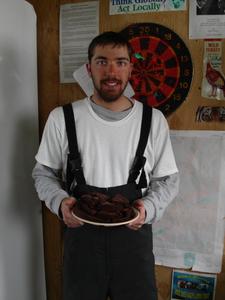
Sean, the proud baker with his moist, scrumptious brownies.
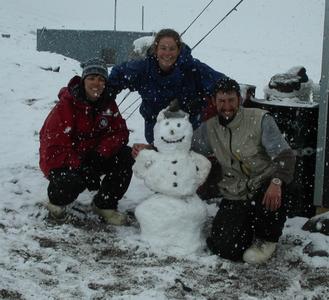
Our Snowman at Camp Bonney. Me, Sarah and Tom.
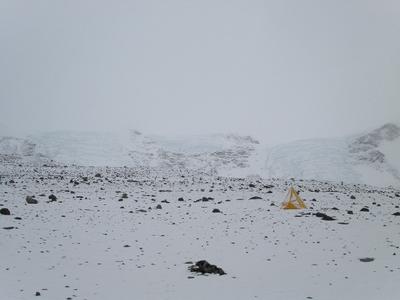
The snowstorm at Lake Bonney Camp (east). This is looking south towards Hughes Glacier.
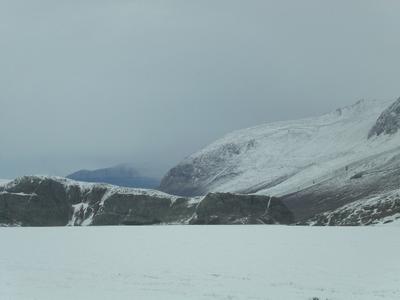
A view west as the storm starts to clear. The other photo is of Tom down by the lake at the height of the snowing.

Bonney Hut jamesway.
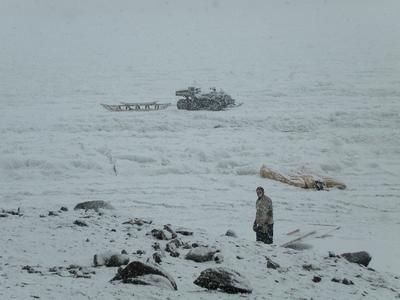
Tom in the snowstorm.
Contact the TEA in the field at
.
If you cannot connect through your browser, copy the
TEA's e-mail address in the "To:" line of
your favorite e-mail package.
|
